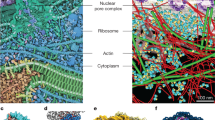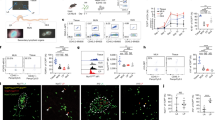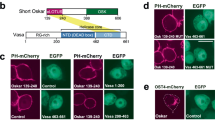Abstract
Functional antibody delivery in living cells would enable the labelling and manipulation of intracellular antigens, which constitutes a long-thought goal in cell biology and medicine. Here we present a modular strategy to create functional cell-permeable nanobodies capable of targeted labelling and manipulation of intracellular antigens in living cells. The cell-permeable nanobodies are formed by the site-specific attachment of intracellularly stable (or cleavable) cyclic arginine-rich cell-penetrating peptides to camelid-derived single-chain VHH antibody fragments. We used this strategy for the non-endocytic delivery of two recombinant nanobodies into living cells, which enabled the relocalization of the polymerase clamp PCNA (proliferating cell nuclear antigen) and tumour suppressor p53 to the nucleolus, and thereby allowed the detection of protein–protein interactions that involve these two proteins in living cells. Furthermore, cell-permeable nanobodies permitted the co-transport of therapeutically relevant proteins, such as Mecp2, into the cells. This technology constitutes a major step in the labelling, delivery and targeted manipulation of intracellular antigens. Ultimately, this approach opens the door towards immunostaining in living cells and the expansion of immunotherapies to intracellular antigen targets.
This is a preview of subscription content, access via your institution
Access options
Access Nature and 54 other Nature Portfolio journals
Get Nature+, our best-value online-access subscription
$29.99 / 30 days
cancel any time
Subscribe to this journal
Receive 12 print issues and online access
$259.00 per year
only $21.58 per issue
Buy this article
- Purchase on Springer Link
- Instant access to full article PDF
Prices may be subject to local taxes which are calculated during checkout






Similar content being viewed by others
References
Chames, P ., Van Regenmortel, M ., Weiss, E. &, Baty, D. Therapeutic antibodies: successes, limitations and hopes for the future. Br. J. Pharmacol. 157, 220–233 (2009).
Leavy, O. Therapeutic antibodies: past, present and future. Nat. Rev. Immunol. 10, 297 (2010).
Herce, H. D., Deng, W., Helma, J., Leonhardt, H. & Cardoso, M. C. Visualization and targeted disruption of protein interactions in living cells. Nat. Commun. 4, 2660 (2013).
Courtete, J. et al. Suppression of cervical carcinoma cell growth by intracytoplasmic codelivery of anti-oncoprotein E6 antibody and small interfering RNA. Mol. Cancer. Ther. 6, 1728–1735 (2007).
Smith, K. G. & Clatworthy, M. R. FcγRIIB in autoimmunity and infection: evolutionary and therapeutic implications. Nat. Rev. Immunol. 10, 328–343 (2010).
Freund, G. et al. Targeting endogenous nuclear antigens by electrotransfer of monoclonal antibodies in living cells. MAbs 5, 518–522 (2013).
Kimura, H., Hayashi-Takanaka, Y., Stasevich, T. J. & Sato, Y. Visualizing posttranslational and epigenetic modifications of endogenous proteins in vivo. Histochem. Cell. Biol. 144, 101–109 (2015).
Marschall, A. L., Frenzel, A., Schirrmann, T., Schungel, M. & Dubel, S. Targeting antibodies to the cytoplasm. MAbs 3, 3–16 (2011).
Biocca, S., Ruberti, F., Tafani, M., Pierandrei-Amaldi, P. & Cattaneo, A. Redox state of single chain Fv fragments targeted to the endoplasmic reticulum, cytosol and mitochondria. Biotechnology 13, 1110–1115 (1995).
Desplancq, D. et al. Targeting the replisome with transduced monoclonal antibodies triggers lethal DNA replication stress in cancer cells. Exp. Cell. Res. 342, 145–158 (2016).
Marschall, A. L., Dubel, S. & Boldicke, T. Specific in vivo knockdown of protein function by intrabodies. MAbs 7, 1010–1035 (2015).
Sato, Y. et al. Genetically encoded system to track histone modification in vivo. Sci. Rep. 3, 2436 (2013).
Worn, A. & Pluckthun, A. Stability engineering of antibody single-chain Fv fragments. J. Mol. Biol. 305, 989–1010 (2001).
Heng, B. C. & Cao, T. Making cell-permeable antibodies (transbody) through fusion of protein transduction domains (PTD) with single chain variable fragment (scFv) antibodies: potential advantages over antibodies expressed within the intracellular environment (intrabody). Med. Hypotheses 64, 1105–1108 (2005).
Gu, Z., Biswas, A., Zhao, M. & Tang, Y. Tailoring nanocarriers for intracellular protein delivery. Chem. Soc. Rev. 40, 3638–3655 (2011).
Kamaly, N., Xiao, Z., Valencia, P. M., Radovic-Moreno, A. F. & Farokhzad, O. C. Targeted polymeric therapeutic nanoparticles: design, development and clinical translation. Chem. Soc. Rev. 41, 2971–3010 (2012).
McNaughton, B. R., Cronican, J. J., Thompson, D. B. & Liu, D. R. Mammalian cell penetration, siRNA transfection, and DNA transfection by supercharged proteins. Proc. Natl Acad. Sci. USA 106, 6111–6116 (2009).
Fuchs, S. M. & Raines, R. T. Arginine grafting to endow cell permeability. ACS Chem. Biol. 2, 167–170 (2007).
Cronican, J. J. et al. Potent delivery of functional proteins into mammalian cells in vitro and in vivo using a supercharged protein. ACS Chem. Biol. 5, 747–752 (2010).
Zelphati, O. et al. Intracellular delivery of proteins with a new lipid-mediated delivery system. J. Biol. Chem. 276, 35103–35110 (2001).
Liao, X., Rabideau, A. E. & Pentelute, B. L. Delivery of antibody mimics into mammalian cells via anthrax toxin protective antigen. ChemBioChem 15, 2458–2466 (2014).
Khalil, I. A., Kogure, K., Akita, H. & Harashima, H. Uptake pathways and subsequent intracellular trafficking in nonviral gene delivery. Pharmacol. Rev. 58, 32–45 (2006).
Krantz, B. A., Trivedi, A. D., Cunningham, K., Christensen, K. A. & Collier, R. J. Acid-induced unfolding of the amino-terminal domains of the lethal and edema factors of anthrax toxin. J. Mol. Biol. 344, 739–756 (2004).
Brock, R. The uptake of arginine-rich cell-penetrating peptides: putting the puzzle together. Bioconjug. Chem. 25, 863–868 (2014).
Duchardt, F., Fotin-Mleczek, M., Schwarz, H., Fischer, R. & Brock, R. A comprehensive model for the cellular uptake of cationic cell-penetrating peptides. Traffic 8, 848–866 (2007).
Herce, H. D., Garcia, A. E. & Cardoso, M. C. Fundamental molecular mechanism for the cellular uptake of guanidinium-rich molecules. J. Am. Chem. Soc. 136, 17459–17467 (2014).
Ter-Avetisyan, G. et al. Cell entry of arginine-rich peptides is independent of endocytosis. J. Biol. Chem. 284, 3370–3378 (2009).
Tunnemann, G. et al. Cargo-dependent mode of uptake and bioavailability of TAT-containing proteins and peptides in living cells. FASEB J. 20, 1775–1784 (2006).
Lattig-Tunnemann, G. et al. Backbone rigidity and static presentation of guanidinium groups increases cellular uptake of arginine-rich cell-penetrating peptides. Nat. Commun. 2, 453 (2011).
Nischan, N. et al. Covalent attachment of cyclic TAT peptides to GFP results in protein delivery into live cells with immediate bioavailability. Angew. Chem. Int. Ed. 54, 1950–1953 (2015).
Helma, J., Cardoso, M. C., Muyldermans, S. & Leonhardt, H. Nanobodies and recombinant binders in cell biology. J. Cell. Biol. 209, 633–644 (2015).
Hamers-Casterman, C. et al. Naturally occurring antibodies devoid of light chains. Nature 363, 446–448 (1993).
Rothbauer, U. et al. Targeting and tracing antigens in live cells with fluorescent nanobodies. Nat. Methods 3, 887–889 (2006).
Schumacher, D. et al. Versatile and efficient site-specific protein functionalization by tubulin tyrosine ligase. Angew. Chem. Int. Ed. 54, 13787–123791 (2015).
Martin, R. M. et al. Principles of protein targeting to the nucleolus. Nucleus 6, 314–325 (2015).
Herce, H. D., Rajan, M., Lattig-Tunnemann, G., Fillies, M. & Cardoso, M. C. A novel cell permeable DNA replication and repair marker. Nucleus 5, 590–600 (2014).
Kirchhofer, A. et al. Modulation of protein properties in living cells using nanobodies. Nat. Struct. Mol. Biol. 17, 133–138 (2010).
Dawson, P. E., Muir, T. W., Clark-Lewis, I. & Kent, S. B. Synthesis of proteins by native chemical ligation. Science 266, 776–779 (1994).
Muir, T. W., Sondhi, D. & Cole, P. A. Expressed protein ligation: a general method for protein engineering. Proc. Natl Acad. Sci. USA 95, 6705–6710 (1998).
Hackenberger, C. P. & Schwarzer, D. Chemoselective ligation and modification strategies for peptides and proteins. Angew. Chem. Int. Ed. 47, 10030–10074 (2008).
Muir, T. W. Semisynthesis of proteins by expressed protein ligation. Annu. Rev. Biochem. 72, 249–289 (2003).
Chagin, V. O. et al. 4D visualization of replication foci in mammalian cells corresponding to individual replicons. Nat. Commun. 7, 11231 (2016).
Leonhardt, H. et al. Dynamics of DNA replication factories in living cells. J. Cell Biol. 149, 271–280 (2000).
Amir, R. E. et al. Rett syndrome is caused by mutations in X-linked MECP2, encoding methyl-CpG-binding protein 2. Nat. Genet. 23, 185–188 (1999).
Rett, A. On an until now unknown disease of a congenital metabolic disorder. Krankenschwester 19, 121–122 (1966).
Guy, J., Gan, J., Selfridge, J., Cobb, S. & Bird, A. Reversal of neurological defects in a mouse model of Rett syndrome. Science 315, 1143–1147 (2007).
Thomas, C. E., Ehrhardt, A. & Kay, M. A. Progress and problems with the use of viral vectors for gene therapy. Nat. Rev. Genet. 4, 346–358 (2003).
Brero, A. et al. Methyl CpG-binding proteins induce large-scale chromatin reorganization during terminal differentiation. J. Cell. Biol. 169, 733–743 (2005).
Acknowledgements
We thank K. K. Hassanin and A. Lehmkuhl for excellent technical assistance. We are grateful to J. Hewing and A. Krella for the generation and characterization of MaSat fusion and PCNA expression constructs, respectively, and R. Kühne for providing the pGEX4T1eGFP plasmid. Furthermore, we thank J. Helma for his great support during the nanobody cloning and expression. This work was supported by grants from the Deutsche Forschungsgemeinschaft (SPP1623) to M.C.C. (CA 198/8-2), C.P.R.H. (HA 4468/9-1) and H.L. (LE 721/13-2), the Einstein Foundation Berlin (Leibniz-Humboldt Professorship) and the Boehringer-Ingelheim Foundation (Plus 3 award) to C.P.R.H., the Fonds der Chemischen Industrie to C.P.R.H. and to D.S. (Kekulé fellowship) and A.F.L.S (Chemiefonds fellowship) and the Nanosystems Initiative Munich to H.L.
Author information
Authors and Affiliations
Contributions
H.D.H. and D.S. contributed equally. M.C.C., H.L. and C.P.R.H. designed and conceived the project. H.D.H. conceived and performed the cellular uptake experiments, the relocalization-based visualization assay, the uptake of recombinant GFP and Mecp2–GFP, PCNA relocalization and the modified F3H assay and microscale thermophoresis measurements to determine the binding constant of functionalized nanobodies. D.S. designed and optimized the cell-permeable nanobody synthesis, cloned and expressed GBP–intein–CBD fusions, established the refolding protocol, performed the EPL and analysed all the constructs (MS, CD, binding to GFP), synthesized the linear, cyclic and cleavable CPPs, generated double-functionalized nanobodies and performed eGFP expression and purification. A.F.L.S. generated the GBP11-117A3–intein–CBD fusion, established a purification strategy, performed EPLs and synthesized cCPPs. A.K.L. purified recombinant proteins and performed some cellular uptake experiments as well as RNA isolation and RNA-binding assays. F.A.M. optimized the EPL conditions and synthesized cCPPs. M.F. generated and characterized the cell lines with the permanent expression of GFP and its fusions. M.-A.K. synthesized Cy5. S.R. performed the cloning and initial testing of the GBP–intein–CBD fusions. E.K. contributed to the matrix-assisted laser desorption ionization measurements. H.L. provided the nanobodies. H.D.H. and D.S. wrote the manuscript supported by M.C.C., C.P.R.H., F.A.M., A.F.L.S. and A.K.L.
Corresponding authors
Ethics declarations
Competing interests
The authors declare no competing financial interests.
Supplementary information
Supplementary information
Supplementary information (PDF 6612 kb)
Supplementary movie
Supplementary movie 1 (MP4 7845 kb)
Supplementary movie
Supplementary movie 2 (MOV 615 kb)
Rights and permissions
About this article
Cite this article
Herce, H., Schumacher, D., Schneider, A. et al. Cell-permeable nanobodies for targeted immunolabelling and antigen manipulation in living cells. Nature Chem 9, 762–771 (2017). https://doi.org/10.1038/nchem.2811
Received:
Accepted:
Published:
Issue Date:
DOI: https://doi.org/10.1038/nchem.2811
This article is cited by
-
Recent advances in chemical protein synthesis: method developments and biological applications
Science China Chemistry (2024)
-
Small molecule-nanobody conjugate induced proximity controls intracellular processes and modulates endogenous unligandable targets
Nature Communications (2023)
-
Pyroptosis inhibiting nanobodies block Gasdermin D pore formation
Nature Communications (2023)
-
Tricyclic cell-penetrating peptides for efficient delivery of functional antibodies into cancer cells
Nature Chemistry (2022)
-
Chemical passports to cross biological borders
Nature Chemistry (2021)



